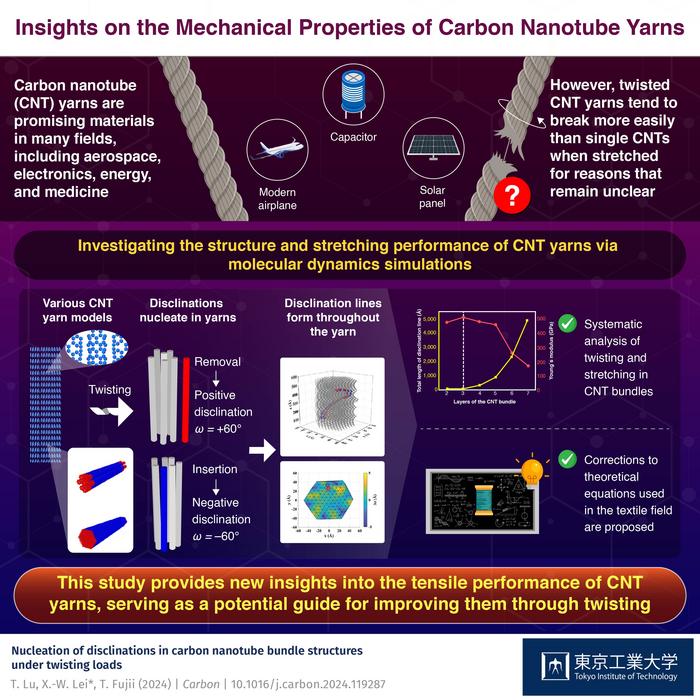Aside from being an essential building block for life, carbon is being actively researched due to its versatility as an engineering material. Carbon nanotubes (CNTs), in particular, have demonstrated tremendous potential for aerospace, semiconductor, and medical applications, mostly owing to their high strength and low weight.

Credit: Tokyo Tech
Aside from being an essential building block for life, carbon is being actively researched due to its versatility as an engineering material. Carbon nanotubes (CNTs), in particular, have demonstrated tremendous potential for aerospace, semiconductor, and medical applications, mostly owing to their high strength and low weight.
Since CNTs are typically short, they need to be weaved into bundles or yarns to expand their practical uses. However, scientists have noted that CNT bundles (CNTBs) and CNT yarns both exhibit a much lower tensile strength than single CNTs when they undergo twisting—this drop in stretching performance can even reach several orders of magnitude! The worst part is that, despite research efforts, the reasons behind this phenomenon remain unclear.
In a recent study published in Carbon on 30 May 2024, a research team led by Associate Professor Xiao-Wen Lei from Tokyo Institute of Technology, Japan, sought to solve this puzzle. By combining molecular dynamics (MD) simulations and the Delaunay triangulation algorithm, they shed light on what could be happening inside CNTBs as they are twisted.
The researchers designed several CTNB models and setups for the MD simulations, considering different numbers of CNT layers, CNT lengths, twisting angles, and twisting force profiles. After running the simulations, they carefully analyzed how the CNTBs reacted to the stretching before and after twisting.
By observing the cross-section of the twisted CNTBs, the team revealed that the poor mechanical performance of CNTBs and CNT yarns may be caused by what’s known as ‘wedge disclinations.’ To understand what these are, one should first know that CNTs naturally arrange themselves in hexagonal patterns when bundled. A disclination refers to a defect in this pattern, whereby either a CNT is missing from the group of six (positive disclination) or an additional CNT is inserted to form an arrangement of seven (negative disclination).
Based on the simulations, the researchers found that when the CNTBs were twisted, disclinations arose due to local CNT rearrangements. These disclinations formed long, curved disclination lines in CNTBs with more layers. Most importantly, these lines appeared to have a direct effect on the behavior of the CNTBs upon mechanical stretching. “We observed that the presence of disclination lines resulted in a decrease in the Young’s modulus of the CNTBs, with longer disclination lines corresponding to a lower Young’s modulus. The appearance of disclination lines in twisted CNTBs may thus be one of the key reasons for the decline in the mechanical properties of the CNT yarns,” explains Lei.
Taken together, the findings of this study help explain some of the current limitations of CNTBs and hint at potential solutions to realize high-performance CNT yarns through twisting. “Leveraging insights gained from understanding the correlation between microscopic internal stacking structural changes and mechanical properties caused by the introduction of lattice defects in materials could pioneer a new academic field related to computational materials science,” highlights Lei. “We ultimately aim for our research to contribute to the realization of a smart, sustainable, and prosperous society in the near future.”
With any luck, the current challenges associated with CNTs will soon be addressed so that these amazing materials help us push the state of the art further.
###
About Tokyo Institute of Technology
Tokyo Tech stands at the forefront of research and higher education as the leading university for science and technology in Japan. Tokyo Tech researchers excel in fields ranging from materials science to biology, computer science, and physics. Founded in 1881, Tokyo Tech hosts over 10,000 undergraduate and graduate students per year, who develop into scientific leaders and some of the most sought-after engineers in industry. Embodying the Japanese philosophy of “monotsukuri,” meaning “technical ingenuity and innovation,” the Tokyo Tech community strives to contribute to society through high-impact research.
Journal
Carbon
Method of Research
Experimental study
Subject of Research
Not applicable
Article Title
Nucleation of disclinations in carbon nanotube bundle structures under twisting loads
Article Publication Date
30-May-2024



